Call Us : +91-982 1016 998
Email id : mehul.shah@skino.in
Call Us : +91-982 1016 998
Email id : mehul.shah@skino.in

When considering a casting process, this chart will help you determine which may be the best one for your application. This is only a starting point.
To find out which is the BEST Process for your product call Superkino today
+91-22-2685 8940.
On this quick and easy to use chart, each issue is rated from 1 to 3 (3 being the best or most economical solution).
Casting Methods to Consider
| Issues to Address | Permanent Mold* | Sand Casting* | Die Casting* |
| Strength | 3 | 1 | 2 |
| Surface finish | 2 | 1 | 3 |
| Complex shapes | 2 | 1 | 3 |
| Dimensional Accuracy | 2 | 1 | 3 |
| Tooling or mold Costs | 2 | 3 | 1 |
| Cost per part | 3 | 1 | 2 |
*Permanent Mold : Is often thought of as the process somewhere in between sand castings and die casting.
*Sand Casting : Typically have higher piece price, but lower tooling costs.
*Die Casting : Tooling can be very expensive initially, but the piece price is low.
Gravity Die-casting
Our Permold process is similar to pressure-die casting with the exception that our metal is gravity poured into a mold, as opposed to pressure Injected. This fundamental difference is why our castings are superior in so many different ways.
Denser Casting
Our unique die design system reduces metal turbulence dramatically and therefore virtually eliminates pinhole porosity commonly found in pressure-die casting. Moreover, even machined surfaces are pressure tight.
More Flexible Tooling
Our tooling is much easier and more inexpensive to change down the road when compared to Pressure-die casting. In fact, design changes to high-production dies can often cost as much as a brand New Permold tool.
No "Skin Effect"
Permold casting posses consistent mechanical and physical properties throughout the cross-section. Large bulky castings are actually our cup of tea.
Fully Machinable
Need a tight dimension that just can't be cast? No problem. Our castings are fully machinable. Also, Surfaces can be machined to mirror finishes.
Fully Weldable
Our castings are easily welded into assembly with excellent weld strength. Our castings are commonly welded with extruded aluminum tubing to make-strength structural units.
Shorter Lead-times
Shorter tooling lead-time makes your product to market faster. Shorter production lead-time reduces your excess inventory.
Short Cuts
Stop paying set-up charges and short-run fees. Get lot sizes as low as 250 pcs. without surcharge.
Better Ductility
Our Permold castings have better impact resistance and won't shatter. This is also known as "Louisville Slugger" resistant.
No Blistering or Distortion
Absolutely no casting blistering or distortion even at near melting temperatures.
No Burrs or Flash
All of our castings are hand-trimmed; never by trim press which inevitably leaves burrs and flash as it wears. Thus, our process is perfect for handles or other applications where hands-on contact requires safety.
Molded Inserts
Any metallic or ceramic piece can be cast-in. Saves costs over pressing inserts. Get stronger threads by casting threaded steel, brass, or stainless steel bushings and eliminate drilling and tapping. Reduce weight by casting a steel insert in high stress areas while keeping the bulk of material in lightweight Aluminum. Please consult SUPERKINO for more information on molded inserts.
Powder Coat Ready
Our castings easily take powder coating for a beautiful finish. Pressure-die casting often causes blistering of the powder coat during the heating cycle due to trapped gas.
Alloys
Aluminum Casting Alloys - LM Series BS 1490 1970
| Uses and General Remarks | |
| LM0 | Mainly used for sand castings for electrical, chemical, and food applications. |
| LM2 | One of the two most widely used alloys for all types of die castings. |
| LM4 | The most versatile of the alloys; has very good casting characteristics and Is used for a very wide range of applications. Strength and hardness can be greatly increased by heat treatment. |
| LM5 | Suitable for sand and chill castings requiring maximum resistance to corrosion, e.g. Marine applications. |
| LM6 | Suitable for large, intricate, and thin-walled castings in all types of moulds; Also used where corrosion resistance or ductility is required. |
| LM9 | Used for applications especially low-pressure die castings requiring the characteristics of LM6 but higher tensile properties following heat-treatment. |
| LM10 | Mainly used for sand and chill castings requiring high strength and shock Resistance. Requires special foundry technique; heat-treated. |
| LM12 | Mainly used where a very good machined surface finish and hardness is required. |
| LM13 | Mainly used for pistons. |
| LM16 | Suitable where high mechanical properties are desired in fairly intricate sand or chill castings. Requires heat-treatment. |
| LM18 | Combines good foundry characteristics with high resistance to corrosion. |
| LM20 | Mainly used for die castings. Similar to LM6 but a little better machinability and hardness. |
| LM21 | Generally similar to LM4-M in characteristics and applications but better machinability and higher proof strength. |
| LM22 | Used for chill castings requiring good foundry characteristics with good Ductility. Requires heat treatment. |
| LM24 | One of the two most widely used alloys for all types of die castings. |
| LM25 | Suitable where good resistance to corrosion combined with high strength is required. |
| LM26 | Mainly used for pistons as alternative to LM13. |
| LM27 | A versatile sand and chill casting alloy introduced as an alternative to LM4 and LM21. |
| LM28 | Piston alloy with lower coefficient of expansion than LM13. Requires Special foundry technique. |
| LM29 | Same as LM28 but lower coefficient of expansion. |
| LM30 | For unlined die-cast cylinder blocks with low expansion and excellent wear resistance. |
| Cu | Mg | Si | Fe | Mn | Ni | Zn | Pb | Sn | Ti | Others | |
| LM0 | 0.03 | 0.03 | 0.3 | 0.4 | 0.03 | 0.03 | 0.7 | 0.03 | 0.03 | - | AL99. 5MM |
| LM2 | 0.7.2.5 | 0.03 | 9.0.11.5 | 1.O | 0.5 | 0.5 | 2 | 0.3 | 0.2 | 0.2 | - |
| LM4 | 2.0.4.0 | .15 | 0.6.0 | 0.8 | 0.2.0.6 | 0.3 | 0.5 | 0.1 | 0.1 | 0.2 | - |
| LM5 | 0.1 | 3.0.6.0 | 0.3 | 0.6 | 0.3.0.7 | 0.1 | 0.1 | 0.05 | 0.05 | 0.2 | - |
| LM6 | 0.1 | 0.1 | 10.0.13.0 | 0.6 | 0.5 | 0.1 | 0.1 | 0.1 | 0.05 | 0.2 | - |
| LM9 | 0.1 | 0.2.0.6 | 10.0.13.0 | 0.6 | 0.3.0.7 | 0.1 | 0.1 | 0.1 | 0.05 | 0.2 | - |
| LM10 | 0.1 | 9.5.11.0 | 0.25 | 0.35 | 0.1 | 0.1 | 0.1 | 0.05 | 0.05 | 0.2 | - |
| LM12 | 9.0.11.0 | 0.2.0.4 | 2.5 | 1.0 | 0.6 | 0.5 | 0.8 | 0.1 | 0.1 | 0.2 | - |
| LM13 | 0.7.1.5 | 0.8.1.5 | 10.0.12.0 | 1.0 | 0.5 | 1.5 | 0.5 | 0.1 | 0.1 | 0.2 | - |
| LM16 | 1.0.1.5 | 0.4.0.6 | 4.5.5.5 | 0.6 | 0.5 | 0.25 | 0.1 | 0.1 | 0.05 | 0.2 | - |
| LM18 | 0.1 | 0.1 | 4.5.6.0 | 0.6 | 0.5 | 0.1 | 0.1 | 0.1 | 0.05 | 0.2 | - |
| LM20 | 0.4 | 0.2 | 10.0.13.0 | 1.0 | 0.5 | 0.1 | 0.2 | 0.1 | 0.1 | 0.2 | - |
| LM21 | 3.0.5.0 | 0.1.0.3 | 5.0.7.0 | 1.0 | 0.2.0.6 | 0.3 | 2.0 | 0.2 | 0.1 | 0.2 | - |
| LM22 | 2.8.3.8 | 0.05 | 4.0.6.0 | 0.6 | 0.2.0.6 | 0.15 | 0.15 | 0.1 | 0.05 | 0.2 | - |
| LM24 | 3.0.4.0 | 0.1 | 7.5.9.5 | 1.3 | 0.5 | 0.5 | 0.3 | 0.3 | 0.2 | 0.2 | - |
| LM25 | 0.1 | 0.200.45 | 6.5.7.5 | 0.5 | 0.3. | 0.1 | 0.1 | 0.1 | 0.05 | 0.2 | - |
| LM26 | 2.0.4.0 | 0.5.1.5 | 8.5.10.5 | 1.2 | 0.2 | 1.0 | 1.0 | 0.2 | 0.1 | 0.2 | - |
| LM27 | 1.5.2.5 | 0.3 | 6.0.8.0 | 0.8 | 0.2.0.6 | 0.3 | 1.0 | 0.2 | 0.1 | 0.2 | - |
| LM28 | 1.3.1.8 | 0.8.1.5 | 17.20 | 0.7 | 0.6 | 0.8.1.5 | 0.2 | 0.1 | 0.1 | 0.2 | CR 06;CO 0.5 |
| LM29 | 0.8.1.3 | 0.8.1.3 | 22.25 | 0.7 | 0.6 | 0.8.1.3 | 0.2 | 0.1 | 0.1 | 0.2 | CR 06;CO 0.5 |
| LM30 | 4.0.5.0 | 0.4.0.7 | 16.18 | 1.11 | 0.3 | 0.1 | 0.2 | 0.1 | 0.1 | 0.2 | - |
Typical Mechanical Properties - Sand cast
| BS 1490 1970 | 0.2% proof stress (N/mm) | Tensile stress (N/mm) | Elongation (%) | Brinell hardness number |
| LM0-M | 30 | 80 |
30 | 25 |
| LM2-M | - | - | - | - |
| LM4-M | 100 | 150 | 2 | 70 |
| LM4-TF | 250 | 280 | 1 | 105 |
| LM5-M | 90 | 170 | 5 | 60 |
| LM6-M | 70 | 170 | 8 | 55 |
| LM9-M | - | - | - | - |
| LM9-TE | 120 | 180 | 2 | 70 |
| LM9-TF | 220 | 250 | - | 100 |
| LM10-TB | 180 | 310 | 15 | 85 |
| LM12-M | - | - | - | - |
| LM13-TE | - | - | - | - |
| LM13-TF | 200 | 200 | - | 115 |
| LM13-TF7 | 140 | 150 | 1 | 75 |
| LM16-TB | 130 | 210 | 3 | 80 |
| LM16-TF | 240 | 280 | 1 | 100 |
| LM18-M | 70 | 120 | 5 | 40 |
| LM20-M | - | - | - | - |
| LM21-M | 130 | 180 | 1 |
85 |
| LM22-TB | - | - | - | - |
| LM24-M | - | - | - | - |
| LM25-M | 90 | 140 | 2.5 | 60 |
| LM25-TE | 130 | 170 | 1.5 | 70 |
| LM25-TB7 | 100 | 170 | 3 | 65 |
| LM25-TF | 220 | 250 | - | 105 |
| LM26-TE | - | - | 2 | - |
| LM27-M | 90 | 150 | - | 75 |
| LM28-TE | - | - | 0.5 | - |
| LM28-TF | 120 | 130 | 0.3 | 120 |
| LM29-TE | 120 | 130 | 0.3 | 120 |
| LM29-TF | 120 | 130 | - | 120 |
| LM30-M | 120 | - | - | - |
| LM30-TS | - | - | - | - |
Typical Mechanical Properities - Chill Cast
| 0.2% proof stress (N/mm) | Tensile strength (N/mm) | Elongation (%) | Brinell hardness Number | BS 1490 1970 |
| 30 | 80 | 40 | 25 | LM0-M |
| 90 | 180 | 2 | 80 | LM2-M |
| 100 | 200 | 3 | 80 | LM4-M |
| 250 | 310 | 3 | 110 | LM-4TF |
| 90 | 230 | 10 | 65 | LM5-M |
| 80 | 200 | 13 | 60 | LM6-M |
| - | 200 | 3 | - | LM9-M |
| 150 | 250 | 2.5 | 80 | LM9-TE |
| 280 | 310 | 1 | 110 | LM9-TF |
| 180 | 360 | 20 | 95 | LM10-TB |
| 150 | 180 | - | 95 | LM12-M |
| - | 220 | 1 | 105 | LM13-TE |
| 280 | 290 | 1 | 125 | LM13-TF |
| 200 | 210 | 1 | 75 | LM13-TF7 |
| 140 | 250 | 6 | 85 | LM16-TB |
| 270 | 310 | 2 | 110 | LM16-TF |
| 80 | 150 | 6 | 50 | LM18-M |
| 80 | 220 | 7 | 60 | LM20-M |
| 130 | 200 | 2 | 90 | LM21-M |
| 120 | 260 | 9 | 75 | LM22-TB |
| 110 | 200 | 2 | 85 | LM24-M |
| 90 | 180 | 5 | 60 | LM25-M |
| 150 | 220 | 2 | 80 | LM25-TE |
| 100 | 230 | 8 | 65 | LM25-TB7 |
| 240 | 310 | 3 | 105 | LM25-TF |
| 180 | 230 | 1 | 105 | LM26-TE |
| 100 | 180 | 3 | 80 | LM27-M |
| 170 | 190 | 0.5 | 120 | LM28-TE |
| 170 | 200 | 0.5 | 120 | LM28-TF |
| 170 | 210 | 0.3 | 120 | LM29-TE |
| 170 | 210 | 0.3 | 120 | LM29-TF |
| 150 | 150 | - | 110 | LM30-M |
| 160 | 160 | - | 110 | LM30-TS |
Note : The typical properties shown in this table are those of separately cast test bars and may not be Obtanied in all parts of a casting.
Aluminum and Zinc based Alloy die cast Component. We manufacture precision gravity die cast component in Aluminum and zinc based alloys with weights ranging from 30 gms to 100 kgs. single piece. We also help in designing castings from concept stage to get best possible end product.
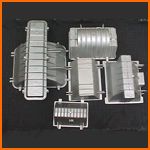
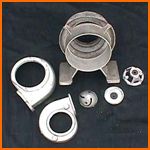
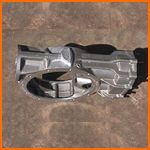
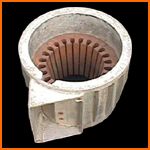
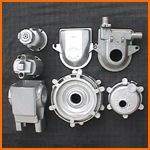
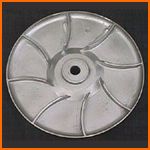
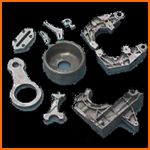
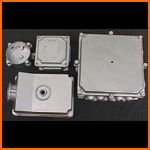
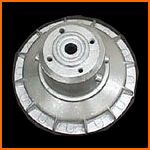
ASTM
TABLE 1 Chemical Composition Limits B-108 permanent Mold
| ANS1 | UNS | Al | Si | Fe | Cu | Mn | Cr | Ni | Zn | Tin | Ti |
| 204.0 | A02040 | Remainder | 0.20 |
0.35 | 4.2-5.0 | 0.15 |
-- |
0.05 |
0.10 | 0.05 | 0.15-0.30 |
| 208.0 | A02080 | Remainder | 2.5-3.5 |
1.2 |
3.5-4.5 | 0.50 |
-- | 0.35 |
1.0 |
-- | 0.25 |
| 222.0 | A02220 | Remainder | 2.0 |
1.5 |
9.2-107.0 | 0.50 |
-- | 0.50 |
0.8 | -- | 0.25 |
| 242.0 | A02420 | Remainder | 0.7 |
1.0 |
3.5-4.5 | 0.35 |
0.25 | 1.7-2.3 | 0.35 | -- | 0.25 |
| 296.0 | -- | Remainder | 2.0-3.0 |
1.2 |
4.0-5.0 | 0.35 |
-- | 0.35 |
0.50 | -- | 0.25 |
| 308.0 | -- | Remainder | 5.0-6.0 |
1.0 |
4.0-5.0 | 0.50 |
-- | … |
1.0 |
-- | 0.25 |
| 319.0 | A03190 | Remainder | 5.5-6.5 |
1.0 |
3.0-4.0 | 0.50 |
-- | 0.35 |
1.0 |
-- | 0.25 |
| 332.0 | A03320 | Remainder | 8.5-10.5 |
1.2 |
2.0-4.0 | 0.50 |
-- | 0.50 |
1.0 |
-- | 0.25 |
| 333.0 | A03330 | Remainder | 8.0-10.0 |
1.0 |
3.0-4.0 | 0.50 |
-- | 0.50 |
1.0 | -- | 0.25 |
| 336.0 | A03360 | Remainder | 11.0-13.0 |
1.2 | 0.50-1.5 | 0.35 |
-- | 2.0-3.0 | 0.35 | -- | 0.25 |
| 354.0 | A03540 | Remainder | 8.6-9.4 |
0.20 | 1.6-2.0 | 0.10 |
-- | -- | 0.10 | -- | 0.20 |
| 355.0 | A03550 | Remainder | 4.5-5.5 |
0.6 | 1.0-1.5 | 0.50 |
0.25 | -- | 0.35 | -- | 0.25 |
| C355.0 | A33550 | Remainder | 4.5-5.5 |
0.20 | 1.0-1.5 | 0.10 |
-- | -- | 0.10 | -- | 0.20 |
| 356.0 | A03560 | Remainder | 6.5-7.5 |
0.6 | 0.25 | 0.35 |
-- | -- | 0.35 | -- | 0.25 |
| A356.0 | A13560 | Remainder | 6.5-7.5 |
0.20 | 0.20 |
0.10 |
-- | -- | 0.10 | -- | 0.20 |
| 357.0 | Remainder | 6.5-7.5 | 0.15 | 0.05 | 0.03 | -- | -- | 0.05 | -- | 0.20 | |
| A357.0 | A13570 | Remainder | 6.5-7.5 | 0.20 | 0.20 |
0.10 | -- | -- | 0.10 | -- | 0.04-0.20 |
| 359.0 | A03590 | Remainder | 8.5-9.5 |
0.20 | 0.20 |
0.10 |
-- | -- | 0.10 | -- | 0.20 |
| 443.0 | A04430 | Remainder | 4.5-6.0 |
0.8 |
0.6 |
0.50 |
0.25 | -- | 0.50 | -- | 0.25 |
| B443.0 | A24430 | Remainder | 4.5-6.0 |
0.8 | 0.15 |
0.35 |
-- | -- | 0.35 | -- | 0.25 |
| A444.0 | A14440 | Remainder | 6.5-7.5 |
0.20 | 0.10 |
0.10 |
-- | -- | 0.10 | -- | 0.20 |
| 513.0 | A05130 | Remainder | 0.30 |
0.40 | 0.10 |
0.30 |
-- | -- | 1.4-2.2 | -- | 0.20 |
| 535.0 | A05350 | Remainder | 0.15 |
0.15 | 0.05 |
0.10-0.25 | -- | -- | …. |
-- | 0.10-0.25 |
| 705.0 | A07050 | Remainder | 0.20 |
0.8 |
0.20 |
0.40-0.6 | 0.20-0.40 | -- | 2.7-3.3 | -- | 0.25 |
| 707.0 | A07070 | Remainder | 0.20 |
0.8 |
0.20 | 0.40-0.6 | 0.20-0.40 | -- | 4.0-4.5 | -- | 0.25 |
| 711.0 | A07110 | Remainder | 0.30 |
0.7-1.4 | 0.35-0.65 | 0.05 |
-- | -- | 6.0-7.0 | -- | 0.20 |
| 713.0 | A07130 | Remainder | 0.25 |
1.1 |
0.40-1.0 | 0.6 |
0.35 | 0.15 | 7.0-8.0 | -- | 0.25 |
| 850.0 | A08500 | Remainder | 0.7 |
0.7 | 0.7-1.3 | 0.10 | -- | 0.7- 1.3 | -- | 5.5-7.0 | 0.20 |
| 851.0 | A08510 | Remainder | 2.0-3.0 |
0.7 | 0.7-1.3 | 0.10 | -- | 0.3-0.7 | -- | 5.5-7.0 | 0.20 |
| 852.0 | A08520 | Remainder | 0.40 | 0.7 | 1.7-2.3 | 0.10 | -- | 0.9-1.5 | -- | 5.5-7.0 | 0.20 |
|
|||||||||||
| TABLE 2 Tensile Requirements | ||||||
| Alloy | Temper | TensileStrength, min,Ksi (Mpa) | Yield Strength(0.2 % offset), min, Ksi (Mpa) | Elongation
in 2in. or 4 X Dia-meter, min, % |
Typical
Hardness 500-Kgf load10- mm ball |
|
| ANS1 | UNS | -- | -- | -- | -- | -- |
| A02040 | T4 separately cast specimens | 48.0(331) |
29.0(200) | 8.0 | -- | |
| A02080 | T4 T6 T7 |
33.0(228) 35.0(241) 33.0(228) |
15.0(103) 22.09(152) 16.0(110) | 4.5 2.0 3.0 |
75 90 80 |
|
| A02220 | T551 T65 |
30.0(207) 40.0(276) |
-- |
D D |
115 140 |
|
| A02420 | T571 T61 |
34.0(234) 40.0(276) |
-- |
D D |
105 110 |
|
| A03190 | F | 27.0(186) | 14.0(97) | 2.5 | 95 | |
| A03360 | T551 T65 |
31.0(214) 40.0(276) |
-- | D D |
105 125 |
|
| A03320 | T5 | 31.0(214) | -- | D | 105 | |
| A03330 | F T5 T6 T7 |
28.0(193) 30.0(207) 35.0(241) 31.0(214) |
-- |
D D D D |
90 100 105 90 |
|
| A03540 | T61 | -- | -- | -- | -- | |
| Separately cast specimens castings, | 48.0(331) | 37.0(255) | 3.0 | -- | ||
| designated area castings | 47.0(324) | 36.0(248) | 3.0 | -- | ||
| no location designated | 43.0(297) | 33.0(228) | 2.0 | -- | ||
| T62 | -- | -- | -- | -- | ||
| Separately cast specimens castings, | 52.0(359) | 42.0(290) | 2.0 | -- | ||
| designated area castings, | 50.0(344) | 42.0(290) | 2.0 | -- | ||
| no location designated | 43.0(297) | 33.0(228) | 2.0 | -- | ||
| A03550 | T51 T62 T7 T71 |
27.0(186) 42.0(290) 36.0(248) 34.0(234) |
-- 27.0(186) |
D D D D |
75 105 90 80 |
|
| A33550 | T61 | -- | -- | -- | -- | |
| Separately cast specimens castings, | 40.0(276) | 30.0(207) | 3.0 | 85 | ||
| designated area castings, | 40.0(276) | 30.0(207) | 3.0 | -- | ||
| no location designated | 37.0(255) | 30.0(207) | 1.0 | 90 | ||
| A03560 | F T6 T71 |
21.0(145) 33.0(228) 25.0(172) |
… 22.0(152) … |
3.0 3.0 3.0 |
85 85 70 |
|
| A13560 | T61 |
-- | -- | -- | -- | |
| Separately cast specimens castings, | 38.0(262) | 26.0(179) | 5.0 | 80 | ||
| designated area castings, | 33.0(228) | 26.0(179) | 5.0 | -- | ||
| no location designated | 28.0(193) | 26.0(179) | 3.0 | 90 | ||
| T6 | 45.0(310) | -- | 3.0 | -- | ||
| A13570 | T61 | -- | -- | -- | -- | |
| Separately cast specimens castings, | 45.0(310) | 36.0(248) | 3.0 | 100 | ||
| designated area castings, | 46.0(317) | 36.0(248) | 3.0 | -- | ||
| no location designated | 41.0(283) |
31.0(207) | 3.0 | -- | ||
| A03590 | T61 | -- | -- | -- | -- | |
| Separately cast specimens castings, | 45.0(310) | 34.0(234) | 4.0 | 90 | ||
| designated area castings, | 45.0(310) | 34.0(234) | 4.0 | |||
| no location designated | 40.0(276) | 30.0(207) | 3.0 | |||
| T62 | -- | -- | -- | -- | ||
| Separately cast specimens castings, | 47.0(324) | 38.0(262) | 3.0 | 100 | ||
| designated area castings, | 47.0(324) | 38.0(262) | 3.0 | -- | ||
| no location designated | 40.0(276) | 30.0(207) | 3.0 | -- | ||
| A04430 | F | 21.0(145) | 7.0(49) | 2.0 | 45 | |
| A24430 | F | 21.0(145) |
6.0(41) | 2.5 | 45 | |
| A14440 | T4 | -- | -- | -- | -- | |
| Separately cast specimens castings | 20.0(138) | -- | 20 | -- | ||
| designated area | 20.0(138) | -- | 20 | -- | ||
| A05130 | F |
22.0(152) | 12.0(83) | 2.5 |
60 | |
| A05350 | F |
35.0(241) | 18.0(124) | 8.0 | -- | |
| A07050 | T1
OR T5 |
37.0(255) | 17.0(117) | 10.0 | -- | |
| A07070 | T1 T7 |
42.0(310) 45.0(310) | 25.0(173) 35.0(241) | 4.0 3.0 |
-- | |
| A07110 | T1 | 28.0(193) | 18.0(124) | 7.0 | 70 | |
| A07130 | T1 or T5 | 32.0(221) | 22.0(152) | 4.0 | -- | |
| A08500 | T5 | 18.0(124) | -- | 8.0 | -- | |
| A08510 | T5 T6 |
17.0(117) 18.0(124) | -- | 3.0 8.0 |
-- | |
| A08520 | T5 | 27.0(186) | -- | 3.0 | -- | |
| Alloy | Chemical Composition , (Values in Weight Percent) | Sand Cast | Others | . | ||||||||||
| ANSI | UNS | Al | Si | Fe | Cu | Mn | Mg | Cr | Ni | Zn | Tin | Ti | Each | Total |
| 201 | A02010 | remainder | 0.1 | 0.15 | 4.0-5.2 | 0.20-0.50 | 0.15-0.55 | …. | … | …. | …. | 0.15-0.35 | 0.05 | 0.1 |
| 204 | A02040 | remainder | 0.2 | 0.35 | 4.2-5.0 | 0.1 | 0.15-0.35 | …. | 0.05 | 0.1 | 0.05 | 0.15-0.30 | 0.05 | 0.15 |
| 208 | A02080 | remainder | 2.5-3.5 | 1.2 | 3.5-4.5 | 0.5 | 0.1 | …. | 0.35 | 1 | …. | 0.25 | … | 0.5 |
| 222 | A02220 | remainder | 2 | 1.5 | 3.7-4.5 | 0.5 | 0.15-0.35 | …. | 0.5 | 0.8 | …. | 0.25 | … | 0.35 |
| 242 | A02420 | remainder | 0.7 | 1 | 9.2-10.7 | 0.35 | 1.2-1.8 | 0.25 | 1.7-2.3 | 0.35 | …. | 0.25 | 0.05 | 0.15 |
| A242.0 | A12420 | remainder | 0.6 | 0.8 | 3.7-4.5 | 0.1 | 1.2-1.7 | 0.15-0.25 | 1.8-2.3 | 0.1 | …. | 0.07-0.20 | 0.05 | 0.15 |
| 295 | A02950 | remainder | 0.7-1.5 | 1 | 4.0-5.0 | 0.35 | 0.03 | …. | …. | 0.35 | …. | 0.25 | 0.05 | 0.15 |
| 319 | A03190 | remainder | 5.5-6.5 | 1 | 3.0-4.0 | 0.5 | 0.1 | …. | 0.35 | 1 | …. | 0.25 | … | 0.5 |
| 328 | A03280 | remainder | 7.5-8.5 | 1 | 1.0-2.0 | 0.20-0.6 | 0.20-0.6 | 0.35 | 0.25 | 1.5 | …. | 0.25 | … | 0.5 |
| 355 | A03550 | remainder | 4.5-5.5 | 0.6 | 1.0-1.5 | 0.5 | 0.40-0.6 | 0.25 | …. | 0.35 | …. | 0.25 | 0.05 | 0.15 |
| C355.0 | A33550 | remainder | 4.5-5.5 | 0.2 | 1.0-1.5 | 0.1 | 0.40-0.6 | …. | …. | 0.1 | …. | 0.25 | 0.05 | 0.15 |
| 356 | A03560 | remainder | 6.5-7.5 | 0.6 | 0.25 | 0.35 | 0.20-0.45 | …. | …. | 0.35 | …. | 0.2 | 0.05 | 0.15 |
| A356.0 | A13560 | remainder | 6.5-7.5 | 0.2 | 0.2 | 0.1 | 0.25-0.45 | …. | … | 0.1 | …. | 0.25 | 0.05 | 0.15 |
| 443 | A04430 | remainder | 4.5-6.0 | 0.8 | 0.6 | 0.5 | 0.05 | 0.25 | … | 0.5 | …. | 0.2 | … | 0.35 |
| B443.0 | A24430 | remainder | 4.5-6.0 | 0.8 | 0.15 | 0.35 | 0.05 | …. | … | 0.35 | …. | 0.25 | 0.05 | 0.15 |
| 514 | A05140 | remainder | 0.35 | 0.5 | 0.15 | 0.35 | 3.5-4.5 | …. | … | 0.15 | … | 0.25 | 0.05 | 0.15 |
| 520 | A05200 | remainder | 0.25 | 0.3 | 0.25 | 0.15 | 9.5-10.6 | …. | … | 0.15 | … | 0.25 | 0.05 | 0.15 |
| 535 | A05350 | remainder | 0.15 | 0.15 | 0.05 | 0.10-0.25 | 6.2-7.5 | …. | … | …. | .. | 0.25 | 0.05 | 0.15 |
| 705 | A07050 | remainder | 0.2 | 0.8 | 0.2 | 0.40-0.6 | 1.4-1.8 | 0.20-0.40 | …. | 2.7-3.3 | … | 0.10-0.25 | 0.05 | 0.15 |
| 707 | A07070 | remainder | 0.2 | 0.8 | 0.2 | 0.40-0.6 | 1.8-2.4 | 0.20-0.40 | … | 4.0-4.5 | …. | 0.25 | 0.05 | 0.15 |
| 710 | A07100 | remainder | 0.15 | 0.5 | 0.35-0.65 | 0.05 | 0.6-0.8 | …. | … | 6.0-7.0 | …. | 0.25 | 0.05 | 0.15 |
| 712 | A07120 | remainder | 0.3 | 0.5 | 0.25 | 0.1 | 0.50-0.65 | 0.40-0.6 | …. | 5.0-6.5 | …. | 0.25 | 0.05 | 0.2 |
| 713 | A07130 | remainder | 0.25 | 1.1 | 0.40-1.0 | 0.6 | 0.20-0.50 | 0.35 | 0.15 | 7.0-8.0 | ….. | 0.15-0.25 | 0.05 | 0.25 |
| 771 | A07710 | remainder | 0.15 | 0.15 | 0.1 | 0.1 | 0.8-1.0 | 0.06-0.20 | …. | 6.5-7.5 | …. | 0.25 | 0.05 | 0.15 |
| 850 | A08500 | remainder | 0.7 | 0.7 | 0.7-1.3 | 0.1 | 0.1 | …. | 0.7-1.3 | … | 5.5-7.0 | 0.10-0.20 | … | 0.3 |
| 851 | A08510 | remainder | 2.0-3.0 | 0.7 | 0.7-1.3 | 0.1 | 0.1 | …. | 0.30-1.3 | … | 5.5-7.0 | 0.2 | ….. | 0.3 |
| 852 | A08520 | remainder | 0.4 | 0.7 | 1.7-2.3 | 0.1 | 0.6-0.9 | …. | 0.9-1.5 | … | 5.5-7.0 | 0.2 | …. | 0.3 |
| ASTM alloy designations are recorded in Practice B 275. | ||||||||||||||
| Contains silver 0.40 - 1.0 %. | ||||||||||||||
| If iron exceeds 0.45 %, manganese content shall not be less than one half of the iron content. | ||||||||||||||
| Contains beryllium 0.003-0.007 %, boron 0.005 % max. | ||||||||||||||
| 710.0 formerly A712.0, 712.0 formerly d712.0, 851.0 formerly A850.0, 852.0 formerly b850.0 | ||||||||||||||
| Includes listed elements for which no specific limit is shown. | ||||||||||||||
TABLE 2[M] Tensile Requirements (SI Units)
NOTE
1- For purposes of determining conformance with this specification, each
value for tensile strength and
yield strength shall be rounded to the nearest 1 Mpa and each value for
elongation shall be rounded to the
nearest 0.5 % both in accordance with the rounding method of Recommended
practice E 29.
| Alloy | . | Temper | Tensile Strength min, Mpa | Yield Strength (0.2 % offset), min, Mpa | Elongation in 5X diameter, min % | Typical Brinell Hardness 500 kgf, 10mm |
| ANSI | UNS | |||||
| 201 | A02010 | T7 | 415 | 345 | 3 | … |
| 204 | A02040 | T4 | 310 | 195 | 6 | … |
| 208 | A02080 | F | 130 | 85 | 1.5 | 55 |
| 222 | A02220 | O | 160 | C | C | 80 |
| -- | -- | T61 | 205 | C | C | 115 |
| 242 | A02420 | O | 160 | C | C | 70 |
| . | . | T61 | 220 | 140 | C | 105 |
| A242 | A12420 | T75 | 200 | C | 1 | 75 |
| 295 | A02950 | T4 | 200 | 90 | 6 | 60 |
| . | . | T6 | 220 | 140 | 3 | 75 |
| . | . | T62 | 250 | 195 | C | 95 |
| . | . | T7 | 200 | 110 | 3 | 70 |
| 319 | A03190 | F | 160 | 90 | 1.5 | 70 |
| . | . | T5 | 170 | C | C | 80 |
| . | . | T6 | 215 | 140 | 1.5 | 80 |
| 328 | A03280 | F | 170 | 95 | 1 | 60 |
| . | . | T6 | 235 | 145 | 1 | 80 |
| 355 | A03550 | T6 | 220 | 140 | 2 | 80 |
| . | . | T51 | 170 | 125 | C | 65 |
| . | . | T71 | 205 | 150 | C | 75 |
| C355 | A33550 | T6 | 250 | 170 | 2.5 | … |
| 356 | A03560 | F | 130 | C | 2 | 55 |
| . | . | T6 | 205 | 140 | 3 | 70 |
| . | . | T7 | 215 | C | C | 75 |
| . | . | T51 | 160 | 110 | C | 60 |
| . | . | T71 | 170 | 125 | 3 | 60 |
| A356.0 | A13560 | T6 | 235 | 165 | 3.5 | … |
| 443 | A04430 | F | 115 | 50 | 3 | 40 |
| B443.0 | A24430 | F | 115 | 40 | 3 | 40 |
| 514 | A025140 | F | 150 | 60 | 6 | 50 |
| 520 | A05200 | T4 | 290 | 150 | 12 | 75 |
| 535 | A05350 | F | 240 | 125 | 9 | 70 |
| 705 | A07070 | T5 | 205 | 115 | 5 | 65 |
| 707 | A07100 | T7 | 255 | 205 | 1 | 80 |
| 710 | A07100 | T5 | 220 | 140 | 2 | 75 |
| 712 | A07120 | T5 | 235 | 170 | 4 | 75 |
| 713 | A07130 | T5 | 220 | 150 | 3 | 75 |
| 771 | A07710 | T5 | 290 | 260 | 1.5 | 100 |
| . | . | T51 | 220 | 185 | 3 | 85 |
| . | . | T52 | 250 | 205 | 1.5 | 85 |
| . | . | T6 | 290 | 240 | 5 | 90 |
| .. | . | T71 | 330 | 310 | 2 | 120 |
| 850 | A08500 | T5 | 110 | C | 5 | 45 |
| 851 | A08510 | T5 | 115 | C | 3 | 45 |
| 852 | A08520 | T5 | 165 | 125 | C | 60 |
| If
agreed upon between the manufacturer and the purchaser, other mechanical
properties
may be obtained by other heat treatments such as annealing, aging
or stress relieving. For
explained of the SI unit Mpa see Appendix X2. Not required For
information only, not required for acceptance. Yield
strength to be determined only when specified in the contract or purchase
order. Formerly
designated as 222.0-T2 and 242.0-T21. ASTM
alloy designations are recorded in Practice B 275. 710.0
formerly A712.0, 712.0 formerly D712.0, 851.0 formerly A850.0, 852.0 formerly
B850.0 Temper
designations.
F
As fabricated.
O
Annealed |
||||||
IS 617 - 1994
Chemical Composition of cast Aluminum and Its Alloys
| SL No | Design ation |
Copper | Silicion | Magnesuim | Iron | Manganese |
Nickel | Zinc | Lead | Tin | Titanium | Aluminum |
| 1 | 1900 | 0.2 | 0.5 |
0.05 |
0.6 |
0.2 |
0.1 |
0.1 | 0.05 | 0.05 | - |
99.0
Min |
| 2 | 1950 | 0.03 | 0.3 |
0.03 |
0.4 |
0.03 |
0.03 |
0.07 | 0.03 | 0.03 | - | 99.5 Min |
| 3 | 2280 | 4.0-5.0 | 0.25 |
0.1 |
0.25 |
0.1 |
0.1 |
0.1 | 0.05 | 0.05 | 0.2-0.3 | Remainder |
| 4 | 2285 | 3.5-4.5 | 0.7 |
1.2-1.8 |
0.7 |
0.6 |
1.7-2.3 | 0.1 | 0.05 | 0.05 | 0.2 | Remainder |
| 5 | 2550 | 9.0-11.0 | 2.5 |
02-0.4 |
1.0 |
0.6 |
0.5 |
0.8 | 0.1 | 0.1 | 0.2 | Remainder |
| 6 | 4223 | 2.0-4.0 | 4.0-6.0 | 0.15 |
0.8 |
0.2-0.6 | 0.3 |
0.5 | 0.1 | 0.1 | 0.2 | Remainder |
| 7 | 4223A | 2.8-3.8 | 4.0-6.0 | 0.05 |
0.6 |
0.2-0.6 |
0.2 |
40.15 | 0.1 | 0.05 | 0.2 | Remainder |
| 8 | 4225 | 1.0-1.5 | 4.5-6.0 | 0.3-6.0 |
0.8 |
0.5 |
0.3 |
0.5 | 0.2 | 0.1 | 0.2 | Remainder |
| 9 | 4300 | 0.1 | 4.5-6.0 | 0.1 |
0.6 |
0.5 |
0.1 |
0.1 | 0.1 | 0.05 | 0.2 | Remainder |
| 10 | 4323 | 3.0-5.0 | 5.0-7.0 | 0.1-03 |
1.0 | 0.2-0.6 |
0.3 |
2.0 | 0.2 | 0.1 | 0.2 | Remainder |
| 11 | 4420 | 3.0-4.0 | 7.5-9.5 | 0.3 |
1.3 |
0.5 |
0.5 |
3.0 | 0.3 | 0.2 | 0.2 | Remainder |
| 12 | 4423 | 1.5-2.5 | 6.0-8.0 | 0.3 |
0.8 |
0.2-0.6 |
0.3 |
1.0 | 0.2 | 0.1 | 0.2 | Remainder |
| 13 | 4450 | 0.1 | 6.5-7.5 | 0.20-0.45 | 0.5 |
0.3 |
0.1 |
0.1 | 0.1 | 0.05 | 0.2 | Remainder |
| 14 | 4520 | 0.7-2.5 | 9.0-11.5 | 0.3 |
1.0 |
0.5 |
0.5 |
2.0 | 0.3 | 0.2 | 0.2 | Remainder |
| 15 | 4525 | 2.0-4.0 | 8.5-10.5 | 0.5-1.5 |
1.2 |
0.5 |
1.0 |
1.0 | 0.2 | 0.1 | 0.2 | Remainder |
| 16 | 4528 | 1.75-2.5 | 8.5-9.5 | 0.15 | 0.4-0.6 | 0.8 | 0.8 | 0.5 | 0.1 | 0.1 | 0.2 | Remainder |
| 17 | 4600 | 0.1 | 10.0-13.0 | 0.1 |
0.6 |
0.5 |
0.1 |
0.1 | 0.1 | 0.05 | 0.2 | Remainder |
| 18 | 4600A | 0.4 | 10.0.13.0 | 0.2 |
1.0 |
0.5 |
0.1 |
0.2 | 0.1 | 0.1 | 0.2 | Remainder |
| 19 | 4628 |
1.75-2.5 | 11.0-12.5 | 0.3 |
0.7-1.1 | 0.5 |
0.3 |
1.5 | 0.05 | 0.1 | 0.2 | Remainder |
| 20 | 4635 | 0.1 | 10.0-13.0 | 0.2-0.6 | 0.6 | 0.3-0.7 | 0.1 | 0.1 | 0.1 | 0.05 | 0.2 | Remainder |
| 21 | 4652 | 0.7-1.5 | 10.0-13.0 | 0.8-1.5 | 1.0 | 0.5 |
0.7-1.5 | 0.5 | 0.1 | 0.1 | 0.2 | Remainder |
| 22 | 5230 | 0.1 | 0.3 | 3.0-6.0 | 0.6 | 0.3-0.7 | 0.1 | 0.1 | 0.05 | 0.05 | 0.2 | Remainder |
| 23 | 5500 | 0.1 | 0.25 | 9.5-11.0 | 0.4 | 0.1 | 0.1 | 0.1 | 0.05 | 0.05 | 0.2 | Remainder |
Table 2 Tensile Properties of cast Aluminum and Its Alloys( Clause 6.1.1)
| sr.no | Designation | Condition | Tensile strength MPs | % Elongation on 50mm Gauge length | ||
| sand cast | chill cast | sand cast | chill cast | |||
| 1 | 1900 | M | - | - | - | - |
| 2 | 1950 | M | - | - | - | - |
| 3 | 2280 | T4 T6 |
215 275 |
265 310 |
7 4 - |
13 9 |
| 4 | 2285 | T6 | 215 | 280 | - | - |
| 5 | 2550 | M | - | 170 | - | - |
| 6 | 4223 | M T6 |
140 225 |
160 280 |
2 - |
2 - |
| 7 | 4223A | T4 | - | 245 | - | 8 |
| 8 | 4225 | T4 T6 |
175 230 |
230 280 |
2 - |
3 - |
| 9 | 4300 | M | 120 | 140 | 3 | 4 |
| 10 | 4323 | M | 160 | 175 | 1 | 1 |
| 11 | 4420 | M | - | 180 | - | 1.5 |
| 12 | 4423 | M | 140 | 160 | 1 | 2 |
| 13 | 4450 | M T5 T7 T6 |
135 160 160 225 |
160 190 225 275 |
2 1 2.5 - |
3 2 5 2 |
| 14 | 4520 | M | 125 | 150 | - | - |
| 15 | 4525 | T5 | - | 210 | - | - |
| 16 | 4528 | M T5 T6 |
150 140 - |
220 200 320 |
1.0 1.5 - |
1.5 3 2 |
| 17 | 4600 | M | 165 | 190 | 5 | 7 |
| 18 | 4600A | M | 165 | 190 | 5 | 5 |
| 19 | 4628 | M | - | 270 | - | 1.5 |
| 20 | 4635 | M T5 T6 |
- 170 240 |
190 230 295 |
- 1.5 - |
3 2 - |
| 21 | 4652 | T5 T6 T7 |
- 140 175 |
210 200 280 |
- - - |
- - - |
| 22 | 5230 | M | 140 | 170 | 3 | 5 |
| 23 | 5500 | T4 | 275 | 310 | 8 | 12 |
NOTE : The tensile properties obtained from separately cast samples
do not necessarily represent line properties from all parts, or in
all directions, of a casting, which will depend on a number of factor
Obtainable from all
parts, or in all directions, ofa
casting, which will depend on a number of factors including
Wall thickness and
cooling characteristics.
Late Mr. Sitaram Shah, Chairman of the company launched a non-ferrous foundry in early sixties, specifically to cater an engineering units in and around Bombay. To build on this foundation, a full fledged machine shop facility was set up where most of the castings were machined before being shipped to the customers, in late sixties.
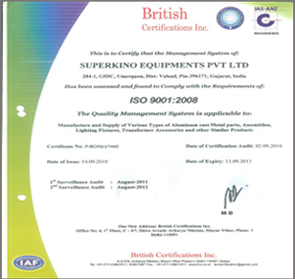
239, Udyog Bhavan, Sonawala Road, Goregaon (E), Mumbai-400 063, Maharashtra (India)
: +91-982 1016 998, 022- 2685 8940